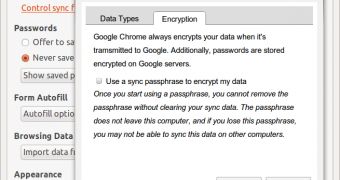Another small feature has made its way into Google Chrome, one that should give security minded folks and conspiracy theory' adepts everywhere some peace of mind.
The sync data - bookmarks, AutoFill, etc. - can now be stored encrypted on the Google servers, ensuring that you and you alone are able to see them. Not that conspiracy theory' adepts are going to use the sync feature anyway.
The new feature is already available in the brand-new Chrome 8 dev release. To enable encryption go to the Preferences dialog and select "Under the hood."
If you have sync enabled, choose the "Customize" option and you will be greeted with the sync customization dialog and the brand new "Encryption" tab.
If you haven't enabled sync, click "Setup sync" enter your account credentials and you should end up with the same customization window.
Note that the sync data is already transmitted in encrypted form from your browser to the Google servers and this has always been the case.
What's new now is the possibility to set up a passphrase to store the data encrypted on the servers as well, ensuring that only someone with knowledge, preferably only you, can use it.
"Once you start using a passphrase, you cannot remove the passphrase without cleaning your sync data. The passphrase does not leave this computer, and if you lose this passphrase, you may not be able to sync this data on other computers," Google describes the feature.
The feature is a nice extra for now, but once password sync is enabled in Google Chrome, it's going to become a lot more important.
Google gets its fair share of criticism, especially when it comes to security, and there are a lot of people that would prefer if the company knew as little about them as possible.
Google Chrome for Windows is available for download here.
Google Chrome for Linux is available for download here.
Google Chrome for Mac is available for download here.

 14 DAY TRIAL //
14 DAY TRIAL //